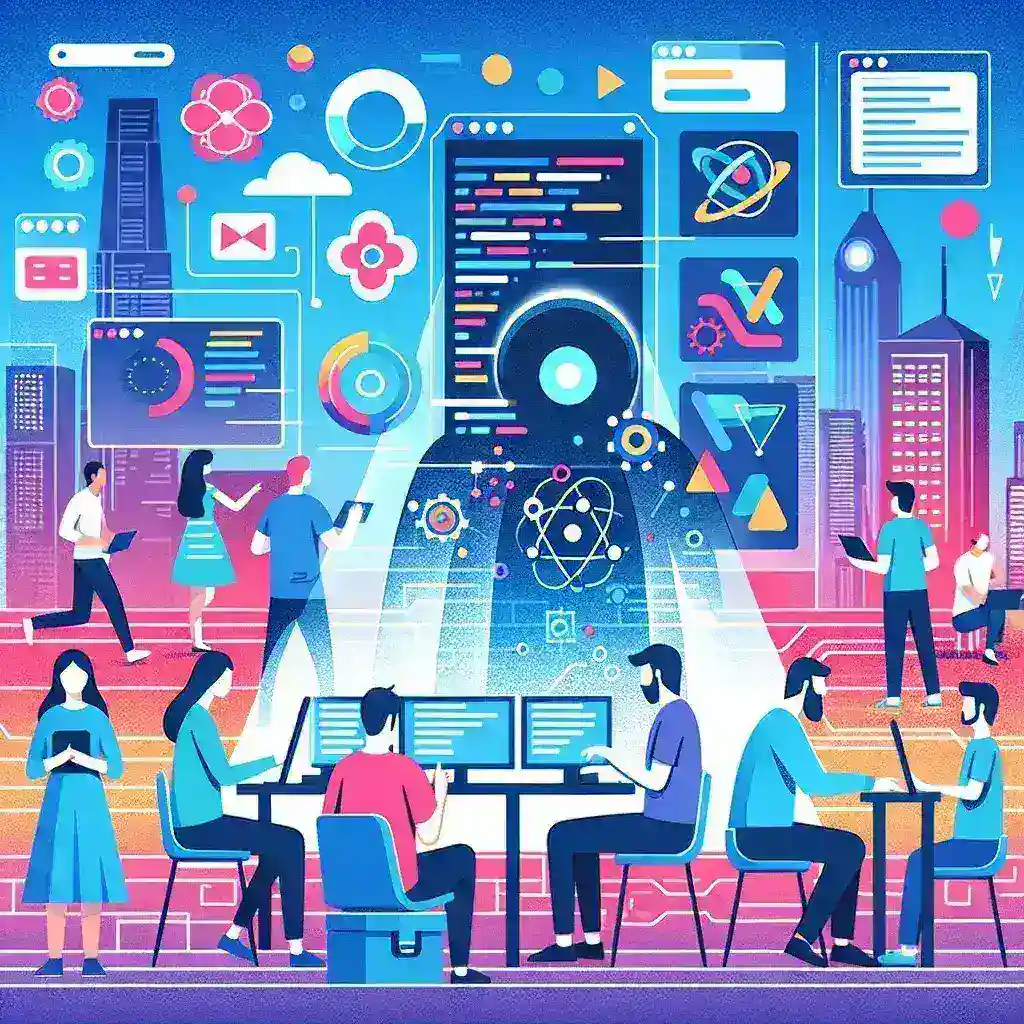React, one of the most popular JavaScript libraries for building user interfaces, has been continuously evolving to meet the demands of modern web development. As we step into 2025, React introduces a plethora of new features and improvements that are set to revolutionize the way we develop web applications. This article delves into the exciting changes and enhancements that React has brought to the table, ensuring that developers can leverage the latest tools and techniques to create more robust and efficient user interfaces.
1. Enhanced Performance
Performance has always been a critical aspect of React, and the updates in 2025 are no exception. React 2025 introduces several optimizations that significantly enhance the performance of applications. One of the most notable improvements is the Concurrent Mode, which has been further refined to provide a smoother user experience. Concurrent Mode allows React to perform updates in a more intelligent and non-blocking manner, ensuring that the user interface remains responsive even during complex state changes.
Another significant enhancement is the introduction of React Fiber 2.0. This new version of the reconciliation algorithm is designed to handle large and complex UIs more efficiently. React Fiber 2.0 optimizes the rendering process by breaking it down into smaller, manageable chunks, allowing the application to prioritize and render the most critical parts first. This results in faster initial loads and smoother interactions, ultimately leading to a better user experience.
2. Improved Developer Tools
Developer tools are an essential part of any modern development workflow, and React 2025 delivers some groundbreaking improvements in this area. The React Developer Tools extension has been overhauled to provide a more intuitive and powerful interface for debugging and profiling your React applications. Some of the key features include:
- Component Hierarchy Visualization: A more detailed and interactive tree view of your components, making it easier to understand the structure and relationships between them.
- Performance Profiling: Enhanced profiling tools that help you identify and optimize performance bottlenecks in your application. This includes detailed insights into component rendering times and the overall performance of your React app.
- State and Props Inspector: An improved inspector that allows you to easily view and modify the state and props of your components in real-time, making debugging a breeze.
- Time Travel Debugging: A new feature that enables you to step through the state changes of your application, helping you pinpoint the exact moment when issues occur and facilitating faster bug resolution.
These enhancements in developer tools not only make development more efficient but also help new developers get up to speed quickly with React’s advanced features.
3. New APIs and Hooks
React 2025 introduces a suite of new APIs and hooks that expand the library’s capabilities and provide developers with more powerful tools for managing state and side effects. Some of the notable additions include:
- useTransition: This hook allows you to mark certain state updates as transitions, which can be delayed or batched to improve performance. Transitions are particularly useful for optimizing user interactions and ensuring that the UI remains responsive during complex state changes.
- useDeferredValue: Similar to
useTransition, this hook helps you defer the rendering of certain components until the current UI update is complete. This is ideal for creating smooth and seamless user experiences, especially in cases where you need to fetch and display data asynchronously. - React Server Components: React Server Components (RSC) are a new feature that allows you to write React components that run on the server and send only the necessary data to the client. This reduces the amount of JavaScript that needs to be downloaded and parsed, leading to faster initial loads and improved SEO.
- useSyncExternalStore: This hook enables you to subscribe to external stores, such as Redux or MobX, and keep your component state in sync with these stores. It simplifies the integration of external state management solutions and ensures that your components are always up-to-date with the latest state.
These new APIs and hooks are designed to make your React applications more efficient, maintainable, and scalable. They provide more granular control over state management and rendering, allowing you to fine-tune your application’s performance and user experience.
4. Better TypeScript Support
TypeScript has become an integral part of modern web development, and React 2025 comes with enhanced TypeScript support to ensure a seamless development experience for TypeScript users. The new version includes:
- Improved Type Definitions: More accurate and comprehensive type definitions for React components, hooks, and APIs, reducing type errors and improving code reliability.
- Automatic Type Inference: React now provides better automatic type inference for props and state, making it easier to write type-safe components without the need for excessive type annotations.
- Better Error Handling: Enhanced error messages and better integration with TypeScript’s type-checking system, helping you identify and fix issues more quickly.
These improvements in TypeScript support make it easier for developers to leverage the benefits of static typing while working with React, leading to more robust and maintainable applications.
5. React Native Enhancements
React Native, the framework for building mobile applications with React, has also received a significant update in 2025. The new version includes:
- Improved Performance: Enhanced performance optimizations that make React Native applications faster and more responsive, particularly on resource-constrained devices.
- Enhanced Animations: A new animation system that provides more control and flexibility, allowing you to create smooth and complex animations with ease.
- Better Platform Integration: Improved integration with native components and APIs, making it easier to build applications that feel truly native on both iOS and Android.
- Web Compatibility: Enhanced web compatibility features that allow you to share more code between your web and mobile applications, reducing duplication and improving development efficiency.
These updates to React Native ensure that developers can build high-performance, cross-platform applications with a more consistent and streamlined development experience.
6. Server-Side Rendering (SSR) Improvements
Server-Side Rendering has been a key focus area for React, and 2025 brings significant improvements to SSR capabilities. React 2025 introduces:
- SSR Streaming: A new streaming SSR mechanism that allows the server to send the initial HTML response to the client in smaller chunks, reducing the time to first meaningful paint and improving user experience.
- Lazy Loading: Enhanced lazy loading support for server-rendered components, ensuring that only the necessary components are loaded and rendered on the initial page load. This reduces the initial payload and improves performance.
- Server Components: As mentioned earlier, React Server Components (RSC) are a game-changer for SSR. They allow you to write components that run on the server and send only the necessary data to the client, making your applications more efficient and faster.
These SSR improvements not only enhance the performance of your applications but also make it easier to build SEO-friendly and accessible web experiences.
7. Developer Experience
The overall developer experience has been significantly improved in React 2025. The React team has focused on making development more enjoyable and productive. Key improvements include:
- Improved Error Messages: More descriptive and actionable error messages that help you quickly identify and resolve issues in your code.
- Enhanced Documentation: Updated and more comprehensive documentation that covers all the new features and best practices, making it easier for developers to learn and adopt React 2025.
- Better Community Support: Enhanced community resources, including forums, tutorials, and community-built tools, that provide developers with the support they need to succeed.
- Simplified Setup: A streamlined setup process that reduces the initial configuration overhead and gets you up and running with React 2025 faster.
These improvements in the developer experience ensure that you can focus more on building your application and less on dealing with setup and configuration issues.
8. Accessibility Enhancements
Accessibility is a critical aspect of web development, and React 2025 introduces several features to help developers create more accessible applications. These include:
- Automated Accessibility Checks: Built-in accessibility checks that run during development and deployment, helping you identify and fix accessibility issues before they affect your users.
- Improved ARIA Support: Enhanced support for ARIA (Accessible Rich Internet Applications) attributes, making it easier to create accessible user interfaces.
- Keyboard Navigation Enhancements: Improved keyboard navigation support that ensures your applications are accessible to users who rely on keyboard input.
- Screen Reader Optimization: New features and best practices that optimize your application for screen readers, ensuring that visually impaired users can use your app effectively.
These accessibility enhancements are crucial for creating inclusive and user-friendly applications that meet the needs of all users.
9. Sustainability and Environmental Impact
As the tech industry becomes more aware of its environmental impact, React 2025 introduces features to help developers build more sustainable applications. These include:
- Energy-Efficient Rendering: New rendering algorithms that minimize energy consumption, making your applications more environmentally friendly.
- Resource Management: Enhanced resource management features that help you optimize the use of system resources, reducing the carbon footprint of your applications.
- Sustainable Development Practices: Best practices and guidelines for building sustainable applications, including tips for minimizing data usage and optimizing performance.
By adopting these sustainable development practices, you can contribute to a more environmentally friendly web ecosystem.
10. Community and Ecosystem Growth
The React community has always been a driving force behind the library’s success, and 2025 sees even more growth in the community and ecosystem. Some highlights include:
- New Libraries and Tools: A surge in the development of new libraries and tools that extend React’s capabilities and provide solutions to common development challenges.
- Increased Adoption: More companies and developers adopting React for their projects, leading to a richer and more diverse ecosystem.
- Improved Learning Resources: A wealth of new learning resources, including tutorials, courses, and community-driven documentation, that make it easier for developers to learn and master React 2025.
- Stronger Community Support: Enhanced community support through forums, meetups, and online communities, ensuring that developers have the resources and support they need to succeed.
With the continued growth of the React community, you can expect a vibrant and supportive environment that fosters innovation and collaboration.
Conclusion
React 2025 brings a host of exciting new features and improvements that are set to transform the way we build web applications. From enhanced performance and developer tools to new APIs, better TypeScript support, and improved accessibility, React continues to evolve to meet the needs of modern developers. By adopting these new features, you can create more efficient, maintainable, and user-friendly applications that stand the test of time. Whether you’re a seasoned React developer or just starting your journey, React 2025 offers a compelling set of tools and techniques to help you succeed in the ever-evolving world of web development.











